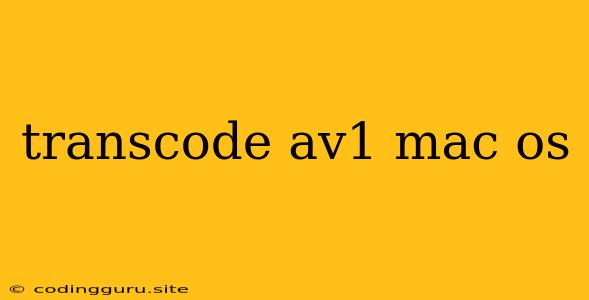Transcoding AV1 on macOS: A Guide to High-Quality Video Conversion
The AV1 codec has taken the world by storm, offering exceptional video quality at significantly lower bitrates compared to traditional codecs like H.264 and H.265. This makes AV1 an ideal choice for streaming, online video platforms, and even local storage. However, transcoding AV1 on macOS can be a bit tricky due to the lack of native support in some applications. This article will guide you through the process of efficiently transcoding AV1 videos on your Mac, ensuring high-quality results every time.
Why Transcode AV1?
Before diving into the specifics, let's understand the importance of transcoding AV1. Here are the key benefits:
- Reduced File Size: AV1 achieves impressive compression, enabling you to store and share your videos with significantly smaller file sizes. This is especially valuable for online platforms, where bandwidth is a crucial consideration.
- Enhanced Quality: Despite the smaller file size, AV1 maintains exceptional video quality. This is achieved through advanced compression techniques that preserve detail and clarity.
- Future-Proofing: As AV1 gains wider adoption, transcoding your videos to this format future-proofs your content for broader compatibility.
Transcoding Methods on macOS
While macOS lacks native AV1 support in certain applications, several options are available for efficient transcoding:
1. Third-Party Applications
Many third-party video editing and transcoding applications offer AV1 support on macOS. Popular choices include:
- DaVinci Resolve: A powerful professional-grade video editing software with built-in AV1 support.
- Handbrake: A free and open-source video transcoder with AV1 support.
- FFmpeg: A command-line tool that provides extensive video processing capabilities, including AV1 transcoding.
2. Online Transcoders
If you don't need complex editing features, online transcoders like CloudConvert and Convertio can handle AV1 conversions directly from your browser. However, these services might have limitations regarding file size and features.
3. Hardware Acceleration
For demanding projects, hardware acceleration can significantly speed up the transcoding process. Certain graphics cards from AMD and NVIDIA offer AV1 encoding acceleration.
4. AV1 Support in Some Applications
Some applications, like QuickTime Player and VLC Media Player, now provide native support for playing back AV1 videos. However, their ability to transcode AV1 remains limited.
Transcoding with FFmpeg
FFmpeg is a versatile command-line tool that provides comprehensive video processing capabilities. Here's how to transcode AV1 with FFmpeg:
-
Install FFmpeg: You can download and install FFmpeg from their official website or use package managers like Homebrew.
-
Open Terminal: Access the Terminal application on your macOS.
-
Run the Command: Execute the following command in Terminal to transcode a video named "input.mkv" to AV1 in a file named "output.mkv":
ffmpeg -i input.mkv -c:v libaom-av1 -b:v 10M -c:a copy output.mkv
Explanation:
- -i input.mkv: Specifies the input video file.
- -c:v libaom-av1: Uses the libav1 codec for AV1 encoding.
- -b:v 10M: Sets the target bitrate to 10 Mbps. Adjust this value according to your desired output quality.
- -c:a copy: Copies the audio stream without re-encoding.
- output.mkv: Sets the name of the output file.
Transcoding with Handbrake
Handbrake is a user-friendly and powerful video transcoder with AV1 support:
-
Download and Install: Get Handbrake from their official website.
-
Open Handbrake: Launch the Handbrake application.
-
Load Video: Select the video you want to transcode.
-
Choose Preset: Handbrake offers various presets. Select a "High Quality" or "Very High Quality" preset for optimal AV1 encoding.
-
Configure Settings:
- Go to the "Video" tab.
- Under "Codec," select "AV1".
- Customize other settings like bitrate and resolution as needed.
-
Start Transcoding: Click the "Start" button to initiate the transcoding process.
Tips for Successful AV1 Transcoding
- Hardware Acceleration: Ensure your computer's graphics card supports AV1 encoding to accelerate the transcoding process.
- Bitrate Optimization: Choose a suitable bitrate for your desired quality and file size. Experiment with different values for optimal results.
- Output Format: AV1 is typically encoded in the MKV container format, which is widely compatible.
Conclusion
Transcoding AV1 on macOS is now more accessible than ever, thanks to advancements in software and hardware. Whether you're a content creator, streamer, or simply want to store your videos efficiently, employing the right tools and techniques will ensure high-quality AV1 transcoding results. By leveraging applications like FFmpeg, Handbrake, and hardware acceleration, you can seamlessly convert your videos to the cutting-edge AV1 codec, maximizing quality and minimizing file sizes for a future-proofed video experience.
